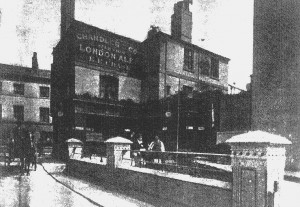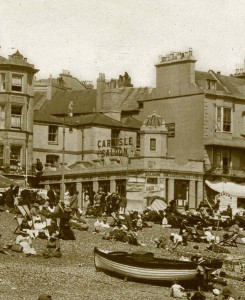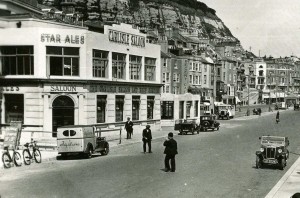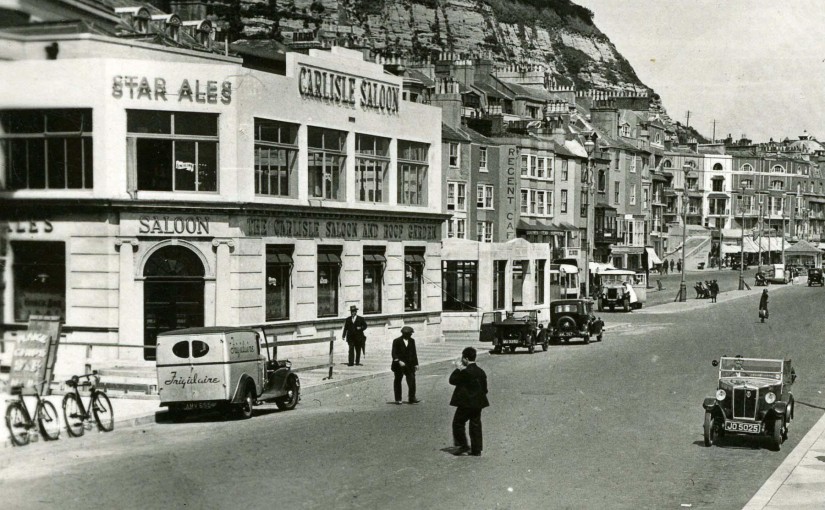By John Hodges
Early in the 19th Century, industry in what was to become the new town of Hastings, consisted only of agriculture with its many hop gardens in the Priory Valley and lime burning on the site of Wellington Square. However, one notable exception to this shortage was perhaps the continuing work provided by Hastings’ oldest industry, ship-building. From the great days when Henry I’s yacht was built on the foreshore, through the naval commitments of the Cinque Ports, Hastings has always had a proud tradition associated with the sea. It was the rise of the Royal Navy that signalled the demise of the Cinque Ports as a naval force, leaving these ancient ports with little more than the few privileges and the historic ceremonies of governance that are still celebrated to this day.

One of the greatest of the ship-building yards was that of Ransom and Ridley located to the east of the Priory Valley on the site of what is now Castle Street. There is little doubt that some of the finest ships ever built in Hastings came out of this shipyard, but the memory of these two great men was not perpetuated in their maritime contribution, but in two rows of houses built out of the proceeds. It was William Ransom who built York Buildings, whilst his partner William Ridley constructed Wellington Place. It was behind what is now Wellington Place that the “old chalk road” ran which ultimately became Caroline Place and Pelham Street. By 1822 this old track had been developed and renamed Caroline Place where it adjoined Ransom and Ripley’s Shipyard whilst the westward continuation became what is now Pelham Street. This fashionable new development was almost certainly named after Caroline of Brunswick, the extremely popular and much maligned queen of George IV. Caroline was so popular with the ordinary people, including those of Hastings, that when the King attempted to introduce a Bill of Pains and Penalties against her in order to deprive her of the title of Queen, and force through his own divorce proceedings, the House of Commons withdrew the Bill.
The Pelham Arms, which was built on the site of the current Carlisle Hotel, was constructed at sometime in the early 1820s to the east of the Priory Stream and the bridge that provided a crossing point. Powell’s Guide of 1819 indicates that there were buildings in the area of what became Pelham Street as there were in many parts of the new town of Hastings that was springing up on the reclaimed land between the cliff face and the high water mark. This reclaimed land was made available for building purposes by removing large sections of the West Hill cliff by several very dangerous methods, that on at least one occasion resulted in the loss of life. Apart from the many boarding houses that were built in this area a number of public and beer houses were constructed to provide for the significant working population that was employed either in the ship building yards, or the supporting trades. One of these early licensed premises was the Shipwrights Arms, located in what today is Castle Street and drawing almost exclusively for their business upon the labour employed in the adjacent Ransom and Ridley’s shipyard. Although the Shipwright’s Arms was first licensed to John Gallop in 1829, it lasted only until the demise of ship building in this area, and in 1835 relocated to Winding Street, where it continued to serve a clientèle that most probably followed it that short distance to the east.

We also know that in the 1850s Pelham Street could also boast of a beer house, by the name of the Waterman’s Arms which was shortly joined by yet another beer house the Prince of Wales. This latter named establishment came within the tied estate of Breeds of Hastings, but at the Brewster Sessions of 1902 its licence was taken away on the grounds that the landlord had been convicted of keeping a “bad house” . This left Breeds the owners with little choice but to sell the now de-licensed property on, and invest the proceeds in another public house from their portfolio. The oldest licensed premises in Pelham Street was however, The Pelham Arms, built on the site of an old tannery by Richard Chandler and first licensed in 1825. This pub became the meeting place for any number of local societies, including politically biased groups but on the lighter side also provided musical entertainment for the general public. This perpetuation of the family name of the Earls of Chichester lasted until 1892 when the old Pelham Arms became the Carlisle Hotel. Only a year before the new landlord T.C.Brown had applied to build a significant extension to the premises, this was refused but more on the grounds that Brown was only a “front man” for the Star Brewery of Eastbourne, with the implication that such an arrangement should preferably provide such benefits only to a local brewer.
Despite this refusal to allow further development to the newly named Carlisle Hotel, changes certainly occurred between the original building in the photograph, and the one depicted in 1923. Further development occurred within the next few years, quite possibly in unison with the creation of the new front line in Hastings, delivering the building that we know today. Over the ensuing years the Carlisle became a popular venue for both musical and sporting events. The latter of these involved the increasingly popular games of snooker and billiards, and during the post war years the main bar possessed a table upon which the great Joe Davis, during an exhibition at the White Rock Pavilion amassed a century break, a rare feat in those days. Perhaps the main association with the Carlisle comes through the many thousands of bikers who have visited, not only for the annual May Day run, but as a local where they were always made welcome. There have been many popular landlords as this seafront location including Tony Shipley, Mike Ford, and Julian Deeprose, but probably the most unusual arrangement concerned the Bishop family who at various times between 1912 and 1956 held the licenses of not only the Carlisle but the Lord Nelson, the Rising Sun, the Kings Head at Ore, the Provincial Hotel in Havelock Road, and the Royal Standard.

The common denominator that ran through this multiple arrangement was the Star Brewery of Eastbourne, a strictly regional brewer owning a tied estate of forty three houses in the vicinity of Eastbourne and Hastings. The Star Brewery, in keeping with nearly all such small undertakings, fell foul of Courage, Barclay, & Simmonds in 1965, who true to form closed the brewery in 1967and absorbed the real prize of the tied estate into their own vast empire. The earliest tie of the Carlisle Hotel to a brewery company was probably to the business of George Porter and William Dieseldorff trading as Chandler & Co. a subsidiary of Ushers Wiltshire Brewery Co. Ltd., which in 1900 became part of Chandlers Wiltshire Brewery based in Hackney Road, Bethnal Green. By 1911 a further change of ownership occurred when fourteen public houses in Hastings and St.Leonards were sold off by Chandlers Wiltshire Brewery to Watney, Combe, Reid & Co. Ltd, with the Carlisle somehow finding its way into the ownership of the Star Brewery. The final change for the Carlisle came following the Lord Young report, and Courage being one of the major brewers was broken up with its vast portfolio of public houses finding new ownership with Inntrepreneur Estates. This was further reduced with sell offs going in many different directions to comply with the limit placed upon individual pub ownership by the Lord Young Report. Whilst this carving up of the Courage tied estate was happening, via a somewhat more circuitous route its brewing business had now come to reside with Wells & Youngs of Bedford.
The Carlisle remains a pleasant pub catering not only for the biking community, but to anyone who appreciates its hospitality and its entertainment. Certainly it brings another dimension to Hastings rich tapestry with its diversity of customers, but in today’s world of themes and repetitiveness this is to be welcomed. Long may it remain as part of our diverse cultural offer, and an example of what identifies our Town and sets it apart from the mundane.
“Hastings Town” January 2014
All articles, photographs and drawings on this web site are World Copyright Protected. No reproduction for publication without prior arrangement. © World Copyright 2015 Cinque Ports Magazines Rye Ltd., Guinea Hall Lodge Sellindge TN25 6EG
